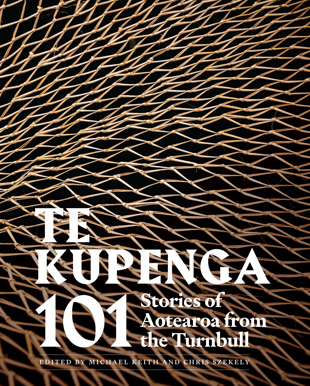Jessie Neilson has reviewed Te Kupenga: 101 stories of Aotearoa from the Turnbull for the Otago Daily Times. You can read the full review below:
101 stories all flavours of Aotearoa
This is a centennial celebration of the Alexander Turnbull archival collection. The bibliophile and compulsive collector claimed all New Zealand-related material to be ‘‘fish for my net’’. Te Kupenga, the net here, has scooped up a wide variety of archival bounty, showcasing a mere morsel from the trove.
As part of the National Library of New Zealand, the Turnbull collection is a legal deposit library, where all published material is kept for posterity. Much has been digitised already as it looks to future safekeeping. As Chief Librarian Chris Szekely outlines in his introduction, the 101 stories told here have been chosen by his colleagues. Some have contributed multiple favourites. The essays are presented in their voices, including five in te reo. They include photographs, portraits, objects, and other ephemera, and between them arc the socio-political makeup of Aotearoa through the last centuries and nearer decades.
The very first piece, a drawing of a ra (a waka sail) hints at dominant themes of migration, settlement, indigeneity, and creative initiative which run through these pages. Another example of craftsmanship is of wooden scaffolding-like stages, put up by Māori for a hakari (a feast when welcoming visitors). This is depicted in a watercolour painting, where the overall creation is intimidating in scale.
A number of portraits have been chosen, such as of eminent Māori as emissaries to London and Vienna; of wahine toa, Heni Pore, who lived through almost a century of war and peace, and Maraea Morete. There is a metal plate from the turn of last century which commemorates famed Rotorua tour guides Maggie and Bella Papakura. Splendid in its datedness, this, like all of the contributions, contains a particular backstory.
Other chosen pieces are of symbolic objects. An illustration of Hutu and Kawa, children’s writer Avis Acres’ storybook fairies, indicates the sentimental styles of the time. A papier mâché pocket globe and its case from the 1700s reflect the care and precision in mapping and expeditions from those exploratory decades. Achinese ‘‘White Pigeon Lottery’’ ticket, or pakapoo, comes from Wellington’s early Chinatown. A Japanese songbook, meticulously copied song by song on to numerous flattened cigarette packets, is a poignant object, found on the body of a prisoner-of-war massacre victim in Featherston.
This wide selection contains all kinds of objects and stories throughout our country’s history, and it is uplifting to see the breadth of ethnicities, experiences, and historical events recorded. On account of this book’s significance, the publisher has committed to providing a copy to every high school in New Zealand. This will be a remarkable resource for young people to peruse. The worth of a collection such as Turnbull’s, as well as its accessibility in a book such as this, cannot be overstated.


